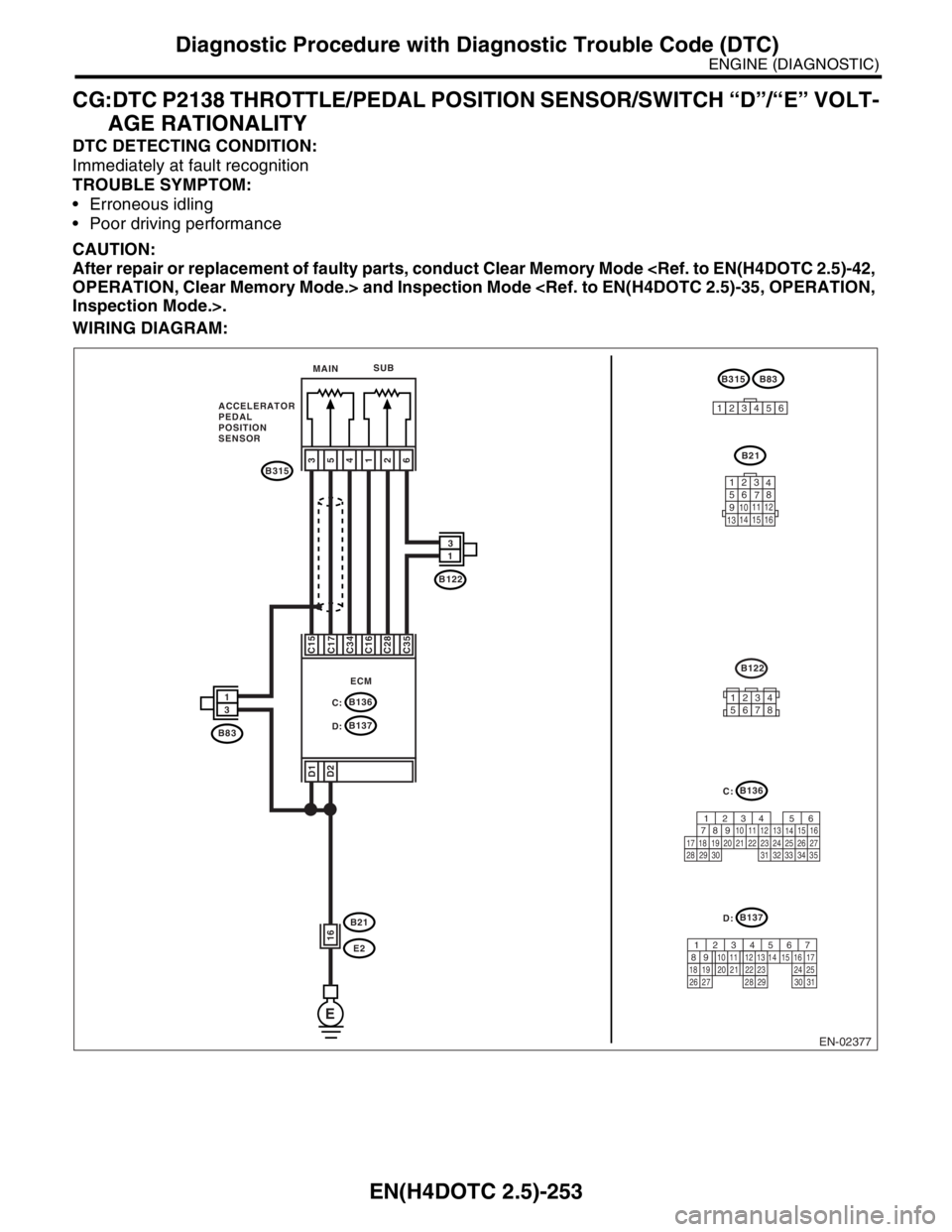2004 SUBARU FORESTER sensor
[x] Cancel search: sensorPage 2276 of 2870

EN(H4DOTC 2.5)-252
ENGINE (DIAGNOSTIC)
Diagnostic Procedure with Diagnostic Trouble Code (DTC)
14 CHECK HARNESS BETWEEN ECM AND
ELECTRONIC THROTTLE CONTROL.
1) Measure the voltage between electronic
throttle control connector and engine ground.
Connector & terminal
(E57) No. 4 (+) — Engine ground (
−):
(E57) No. 6 (+) — Engine ground (
−):
2) Check the voltage change by shaking the
harness and connector of ECM and engine
harness connector while monitoring the value
with voltage meter.Is the voltage less than 10 V? Go to step 15.Repair short circuit
in harness between
ECM connector and
electronic throttle
control connector.
15 CHECK HARNESS BETWEEN ECM AND
ELECTRONIC THROTTLE CONTROL.
1) Turn the ignition switch to OFF.
2) Disconnect the ECM connector.
3) Measure the resistance between ECM con-
nectors.
Connector & terminal
(B136) No. 18 — (B136) No. 35:
(B136) No. 29 — (B136) No. 35:Is the resistance more than 1
MΩ?Go to step 16.Repair short circuit
to sensor power
supply.
16 CHECK ELECTRONIC THROTTLE CON-
TROL HARNESS.
1) Disconnect the connector from ECM.
2) Disconnect the connectors from the elec-
tronic throttle control.
3) Measure the resistance between electronic
throttle control connector terminals.
Connector & terminal
(E57) No. 6 — (E57) No. 4:Is the resistance more than 1
MΩ?Repair the poor
contact in ECM con-
nector. Replace the
ECM if defective.Repair the short
circuit of harness. Step Check Yes No
Page 2277 of 2870

EN(H4DOTC 2.5)-253
ENGINE (DIAGNOSTIC)
Diagnostic Procedure with Diagnostic Trouble Code (DTC)
CG:DTC P2138 THROTTLE/PEDAL POSITION SENSOR/SWITCH “D”/“E” VOLT-
AGE RATIONALITY
DTC DETECTING CONDITION:
Immediately at fault recognition
TROUBLE SYMPTOM:
Erroneous idling
Poor driving performance
CAUTION:
After repair or replacement of faulty parts, conduct Clear Memory Mode
WIRING DIAGRAM:
EN-02377
B315B83
B21
E
C:ECM
B136
B137
D:
C:B136
B137
D:
B122
B21
E2
B315
1
3
354126 C15
C17
C34
C16
C28
C35
D1D2
16
123
4
56
78
9
1011 12
1314 15 16
123456
B122
56
782 1
94 310
24 22 23 2511 12 13
1415
26 27
2816
17 18 19 20 21
33 34 29
32 30
31 35
567
82 1
94 310
22 23 11 12 13 14 15
24 25
2616 17
18 19 20 21
27 28 29 30 31
MAINSUB
ACCELERATOR
PEDAL
POSITION
SENSOR
B833
112345678
Page 2278 of 2870

EN(H4DOTC 2.5)-254
ENGINE (DIAGNOSTIC)
Diagnostic Procedure with Diagnostic Trouble Code (DTC)
Step Check Yes No
1 CHECK ACCELERATOR PEDAL POSITION
SENSOR OUTPUT.
1) Turn the ignition switch to ON.
2) Measure the voltage between ECM con-
nector and terminal.
Connector & terminal
(B136) No. 17 (+) — (B136) No. 34 (
−):
(B136) No. 28 (+) — (B136) No. 35 (
−):
3) Check the voltage change by shaking the
harness and connector of ECM and accelera-
tor pedal position sensor connector and har-
ness.Is the voltage more than 0.4 V? Go to step 2.Go to step 3.
2 CHECK POOR CONTACT.
Check poor contact in connector between
ECM and accelerator pedal position sensor.Is there poor contact? Repair the poor
contact.Go to step 12.
3 CHECK HARNESS BETWEEN ECM AND AC-
CELERATOR PEDAL POSITION SENSOR.
1) Turn the ignition switch to OFF.
2) Disconnect the connector from ECM.
3) Disconnect the connector from the acceler-
ator pedal position sensor.
4) Measure the resistance between ECM con-
nector and accelerator pedal position sensor con-
nector.
Connector & terminal
(B136) No. 15 — (B315) No. 3:
(B136) No. 16 — (B315) No. 1:
(B136) No. 17 — (B315) No. 5:
(B136) No. 28 — (B315) No. 2:Is the resistance less than 1
Ω?Go to step 4.Repair the open
circuit of harness
connector.
4 CHECK HARNESS BETWEEN ECM AND AC-
CELERATOR PEDAL POSITION SENSOR.
Measure the resistance between ECM connec-
tor and chassis ground.
Connector & terminal
(B136) No. 15 — Chassis ground:
(B136) No. 16 — Chassis ground:
(B136) No. 17 — Chassis ground:
(B136) No. 28 — Chassis ground:Is the resistance more than 1
MΩ?Go to step 5.Repair the ground
short circuit of har-
ness.
5 CHECK POWER SUPPLY OF ACCELERA-
TOR PEDAL POSITION SENSOR.
1) Connect the ECM connector.
2) Turn the ignition switch to ON.
3) Measure the voltage between accelerator
pedal position sensor connector and engine
ground.
Connector & terminal
(B315) No. 3 (+) — Engine ground (
−):
(B315) No. 1 (+) — Engine ground (
−):
4) Check the voltage change by shaking the
harness and connector of ECM while monitor-
ing the value with voltage meter.Is the voltage 4.5 — 5.5 V? Go to step 6.Repair the poor
contact in ECM con-
nector. Replace the
ECM if defective.
6 CHECK ACCELERATOR PEDAL POSITION
SENSOR.
Measure the resistance of accelerator pedal
position sensor.
Te r m i n a l s
No. 3 — No. 4:Is the resistance 1.2 — 4.8
kΩ?Go to step 7.Replace the accel-
erator pedal posi-
tion sensor.
Page 2279 of 2870

EN(H4DOTC 2.5)-255
ENGINE (DIAGNOSTIC)
Diagnostic Procedure with Diagnostic Trouble Code (DTC)
7 CHECK ACCELERATOR PEDAL POSITION
SENSOR.
Measure the resistance of accelerator pedal
position sensor.
Te r m i n a l s
No. 1 — No. 6:Is the resistance 0.75 — 3.15
kΩ?Go to step 8.Replace the accel-
erator pedal posi-
tion sensor.
8 CHECK ACCELERATOR PEDAL POSITION
SENSOR.
Measure the resistance of accelerator pedal
position sensor without depressing the accel-
erator pedal.
Te r m i n a l s
No. 5 — No. 4:Is the resistance 0.2 — 0.8
kΩ?Go to step 9.Replace the accel-
erator pedal posi-
tion sensor.
9 CHECK ACCELERATOR PEDAL POSITION
SENSOR.
Measure the resistance of accelerator pedal
position sensor without depressing the accel-
erator pedal.
Te r m i n a l s
No. 2 — No. 6:Is the resistance 0.15 — 0.63
kΩ?Go to step 10.Replace the accel-
erator pedal posi-
tion sensor.
10 CHECK ACCELERATOR PEDAL POSITION
SENSOR.
Measure the resistance of accelerator pedal
position sensor with the accelerator pedal
depressed.
Te r m i n a l s
No. 5 — No. 4:Is the resistance 0.5 — 2.5
kΩ?Go to step 11.Replace the accel-
erator pedal posi-
tion sensor.
11 CHECK ACCELERATOR PEDAL POSITION
SENSOR.
Measure the resistance of accelerator pedal
position sensor with the accelerator pedal
depressed.
Te r m i n a l s
No. 2 — No. 6:Is the resistance 0.28 — 1.68
kΩ?Go to step 12.Replace the accel-
erator pedal posi-
tion sensor.
12 CHECK ACCELERATOR PEDAL POSITION
SENSOR OUTPUT.
1) Turn the ignition switch to OFF.
2) Connect all the connectors.
3) Turn the ignition switch to ON.
4) Read the data of main throttle sensor signal
and sub accelerator pedal position sensor sig-
nal using Subaru Select Monitor.
5) Check the voltage change by shaking the
harness and connector of ECM, engine har-
ness connector and accelerator pedal position
sensor connector harness.Is the voltage less than 4.8 V? Go to step 13.Go to step 14.
13 CHECK POOR CONTACT.
Check poor contact in connector between
ECM and accelerator pedal position sensor.Is there poor contact? Repair the poor
contact.Go to step 19. Step Check Yes No
Page 2280 of 2870

EN(H4DOTC 2.5)-256
ENGINE (DIAGNOSTIC)
Diagnostic Procedure with Diagnostic Trouble Code (DTC)
14 CHECK HARNESS BETWEEN ECM AND AC-
CELERATOR PEDAL POSITION SENSOR.
1) Turn the ignition switch to OFF.
2) Disconnect the connector from ECM.
3) Disconnect the connector from the acceler-
ator pedal position sensor.
4) Measure the resistance between ECM con-
nector and accelerator pedal position sensor con-
nector.
Connector & terminal
(B136) No. 34 — (B315) No. 4:
(B136) No. 35 — (B315) No. 6:Is the resistance less than 1
Ω?Go to step 15.Repair the open
circuit of harness
connector.
15 CHECK HARNESS BETWEEN ECM AND AC-
CELERATOR PEDAL POSITION SENSOR.
1) Connect the ECM connector.
2) Measure the resistance between accelera-
tor pedal position sensor connector and engine
ground.
Connector & terminal
(B315) No. 4 — Engine ground:
(B315) No. 6 — Engine ground:Is the resistance less than 5
Ω?Go to step 16.Repair the poor
contact in ECM con-
nector. Replace the
ECM if defective.
16 CHECK HARNESS BETWEEN ECM AND AC-
CELERATOR PEDAL POSITION SENSOR.
1) Connect the ECM connector.
2) Turn the ignition switch to ON.
3) Measure the voltage between accelerator
pedal position sensor connector and engine
ground.
Connector & terminal
(B315) No. 1 (+) — Engine ground (
−):
(B315) No. 3 (+) — Engine ground (
−):
4) Check the voltage change by shaking the
harness and connector of ECM while monitor-
ing the value with voltage meter.Is the voltage less than 6 V? Go to step 17.Repair battery short
circuit in harness
between ECM con-
nector and acceler-
ator pedal position
sensor connector.
17 CHECK POWER SUPPLY OF ACCELERA-
TOR PEDAL POSITION SENSOR.
1) Measure the voltage between accelerator
pedal position sensor connector and engine
ground.
Connector & terminal
(B315) No. 2 (+) — Engine ground (
−):
(B315) No. 5 (+) — Engine ground (
−):
2) Check the voltage change by shaking the
harness and connector of ECM while monitor-
ing the value with voltage meter.Is the voltage less than 4.8 V? Go to step 18.Repair short circuit
in harness between
ECM connector and
accelerator pedal
position sensor con-
nector.
18 CHECK HARNESS BETWEEN ECM AND AC-
CELERATOR PEDAL POSITION SENSOR.
1) Turn the ignition switch to OFF.
2) Connect the accelerator pedal position sen-
sor connector.
3) Turn the ignition switch to ON.
4) Measure the voltage between ECM connector
and chassis ground.
Connector & terminal
(B136) No. 17 (+) — Chassis ground (
−):
(B136) No. 28 (+) — Chassis ground (
−):Is the voltage less than 4.8 V? Go to step 19.Repair poor contact
in accelerator pedal
position sensor con-
nector. Replace the
accelerator pedal
position sensor if
defective. Step Check Yes No
Page 2281 of 2870

EN(H4DOTC 2.5)-257
ENGINE (DIAGNOSTIC)
Diagnostic Procedure with Diagnostic Trouble Code (DTC)
19 CHECK HARNESS BETWEEN ECM AND AC-
CELERATOR PEDAL POSITION SENSOR.
1) Turn the ignition switch to OFF.
2) Disconnect the connector from ECM.
3) Disconnect the connector from the acceler-
ator pedal position sensor.
4) Measure the resistance between connector
terminals of accelerator pedal position sensor.
Connector & terminal
(B315) No. 5 — (B315) No. 2:Is the resistance more than 1
MΩ?Repair the poor
contact in ECM con-
nector. Replace the
ECM if defective.Repair short circuit
in harness between
ECM connector and
accelerator pedal
position sensor con-
nector. Step Check Yes No
Page 2282 of 2870

EN(H4DOTC 2.5)-258
ENGINE (DIAGNOSTIC)
General Diagnostic Table
19.General Diagnostic Table
A: INSPECTION
1. ENGINE
NOTE:
Malfunction of parts other than those listed is also possible.
Symptom Problem parts
1. Engine stalls during idling.1) Electronic throttle control
2) Manifold absolute pressure sensor
3) Mass air flow and intake air temperature sensor
4) Ignition parts (*1)
5) Engine coolant temperature sensor (*2)
6) Crankshaft position sensor (*3)
7) Camshaft position sensor (*3)
8) Fuel injection parts (*4)
2. Rough idling1) Electronic throttle control
2) Manifold absolute pressure sensor
3) Mass air flow and intake air temperature sensor
4) Engine coolant temperature sensor (*2)
5) Ignition parts (*1)
6) Air intake system (*5)
7) Fuel injection parts (*4)
8) Crankshaft position sensor (*3)
9) Camshaft position sensor (*3)
10) Oxygen sensor
11) Fuel pump and fuel pump relay
3. Engine does not return to idle.1) Electronic throttle control
2) Engine coolant temperature sensor
3) Manifold absolute pressure sensor
4) Mass air flow sensor
4. Poor acceleration1) Manifold absolute pressure sensor
2) Mass air flow and intake air temperature sensor
3) Electronic throttle control
4) Fuel injection parts (*4)
5) Fuel pump and fuel pump relay
6) Engine coolant temperature sensor (*2)
7) Crankshaft position sensor (*3)
8) Camshaft position sensor (*3)
9) A/C switch and A/C cut relay
10) Engine torque control signal circuit
11) Ignition parts (*1)
5. Engine stalls or engine sags or hesitates at
acceleration.1) Manifold absolute pressure sensor
2) Mass air flow and intake air temperature sensor
3) Engine coolant temperature sensor (*2)
4) Crankshaft position sensor (*3)
5) Camshaft position sensor (*3)
6) Purge control solenoid valve
7) Fuel injection parts (*4)
8) Fuel pump and fuel pump relay
6. Surging1) Manifold absolute pressure sensor
2) Mass air flow and intake air temperature sensor
3) Engine coolant temperature sensor (*2)
4) Crankshaft position sensor (*3)
5) Camshaft position sensor (*3)
6) Fuel injection parts (*4)
7) Throttle position sensor
8) Fuel pump and fuel pump relay
Page 2283 of 2870

EN(H4DOTC 2.5)-259
ENGINE (DIAGNOSTIC)
General Diagnostic Table
*1: Check ignition coil & ignitor ASSY and spark plug.
*2: Indicate the symptom occurring only in cold temperatures.
*3: Ensure the secure installation.
*4: Check fuel injector, fuel pressure regulator and fuel filter.
*5: Inspect air leak in air intake system. 7. Spark knock1) Manifold absolute pressure sensor
2) Mass air flow and intake air temperature sensor
3) Engine coolant temperature sensor
4) Knock sensor
5) Fuel injection parts (*4)
6) Fuel pump and fuel pump relay
8. After burning in exhaust system1) Manifold absolute pressure sensor
2) Mass air flow and intake air temperature sensor
3) Engine coolant temperature sensor (*2)
4) Fuel injection parts (*4)
5) Fuel pump and fuel pump relay Symptom Problem parts